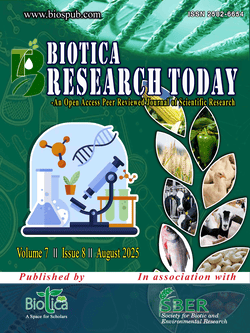
Advancing Fish Health Management: The Role of Next Generation Sequencing (NGS)
Tanuja Abdulla*
ICAR-Central Inland Fisheries Research Institute, Kochi Research Station, Kochi, Kerala (682 018), India
Thankam Theresa Paul
ICAR-Central Inland Fisheries Research Institute, Kochi Research Station, Kochi, Kerala (682 018), India
Deepa Sudheesan
ICAR-Central Inland Fisheries Research Institute, Kochi Research Station, Kochi, Kerala (682 018), India
DOI: NIL
Keywords: Fish health, Microbiome, Next generation sequencing, Pathogenesis
Abstract
Next Generation sequencing techniques were applied in the field of fish and aquatic health management studies over the last few years. The era of genomic sequencing advances from Sanger sequencing to Illumina sequencing, 454 Pyrosequencing, SOLiD Sequencing, Oxford nanopore sequencing etc. with advantage of sequencing of millions of DNA reads in short time with reasonable cost. This tool helps in the detailing of microbial information associated with fish and environmental parameters like fish diseases, host-pathogen interaction studies, pathogen characterization and microbial community diversity assessments. NGS techniques enables novel identification of un-cultivable microbes, bio-prospecting of probiotic and bioremediation bacteria and identification of different strains of pathogens those are difficult to differentiate with conventional diagnostic methods. This information is vital for the development of management strategies in the aquatic ecosystem. This article briefly highlights the application of NGS tools in fish health aspects.
Downloads
not found
Reference
Bacharach, E., Mishra, N., Briese, T., Zody, M.C., Tsofack, J.E.K., Zamostiano, R., Berkowitz, A., Ng, J., Nitido, A., Corvelo, A., Toussaint, N.C., Nielsen, S.C.A., Hornig, M., Pozo, J.D., Bloom, T., Ferguson, H., Eldar, A., Lipkin, W.I., 2016. Characterization of a novel orthomyxo-like virus causing mass die-offs of tilapia. mBio 7(2), e00431-16. DOI: https://doi.org/10.1128/mbio.00431-16.
de Bruijn, I., Liu, Y., Wiegertjes, G.F., Raaijmakers, J.M., 2018. Exploring fish microbial communities to mitigate emerging diseases in aquaculture. FEMS Microbiology Ecology 94(1), fix161. DOI: https://doi.org/10.1093/femsec/fix161.
Mitra, T., Mahanty, A., Ganguly, S., Mohanty, B.P., 2020. Transcriptomic responses to pollution in natural riverine environment in Rita rita. Environmental Research 186, 109508. DOI: https://doi.org/10.1016/j.envres.2020.109508.
Mohammed, E.A.H., Kovács, B., Kuunya, R., Mustafa, E.O.A., Abbo, A.S.H., Pál, K., 2025. Antibiotic resistance in aquaculture: Challenges, trends analysis, and alternative approaches. Antibiotics 14(6), 598. DOI: https://doi.org/10.3390/antibiotics14060598.
Zhang, Y., Nie, P., Lin, L., 2016. Complete genome sequence of the fish pathogen Flavobacterium columnare Pf1. Genome Announcements 4(5), e00900-16. DOI: https://doi.org/10.1128/genomea.00900-16.
